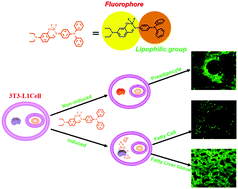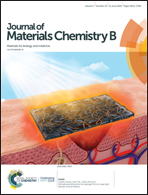Identification of fatty liver disease at diverse stages using two-photon absorption of triphenylamine-based BODIPY analogues†
Abstract
Fatty liver disease (FLD) is one of the major hazards to human health, but effectively and accurately detecting it during its various phases remains challenging. To address this issue, in the current work, four BODIPY analogues (01B–04B) with different donor/acceptor groups were rationally designed. Photophysical and theoretical studies demonstrated an obvious intramolecular charge transfer (ICT) in 03B, with two-photon action cross-sections up to 198 GM in the near-infrared region. An initial in vitro assessment indicated that 03B could interact with the lipid substances with a significant fluorescence enhancement. Due to its high biocompatibility, lipid affinity, and sensitivity, 03B could target model 3T3-L1 cells at various FLD-induced stages. Furthermore, an in vivo study demonstrated the ability to use 03B to clearly distinguish FLD tissue and display a lesion in situ. These results offered a promising optical tool for evaluating FLD at various phases and monitoring its dynamics at the sub-cellular level.



 Please wait while we load your content...
Please wait while we load your content...